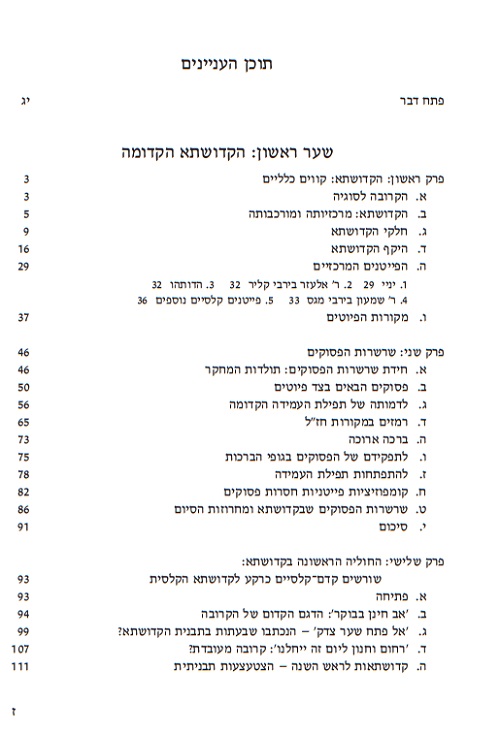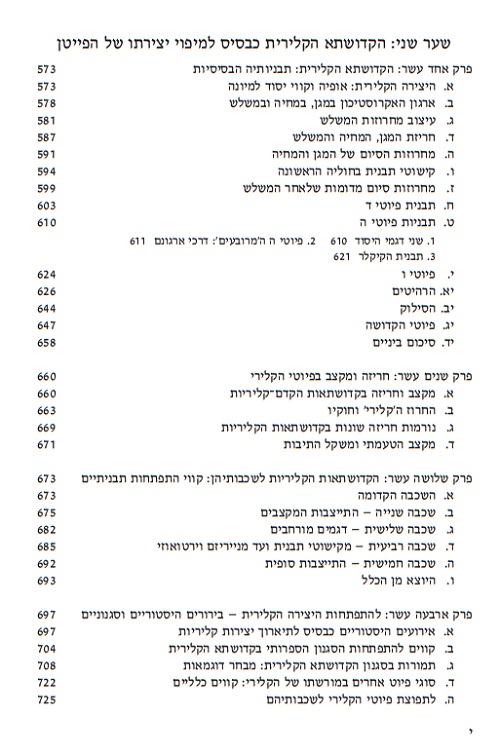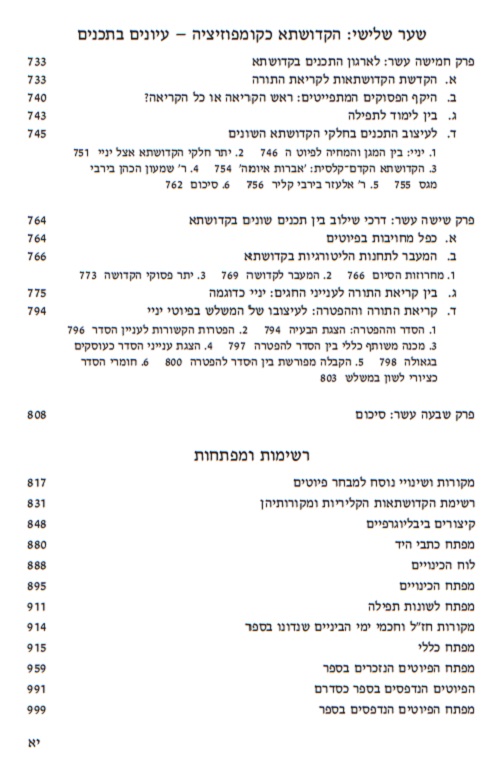Book sale still active
Just a reminder that the sale from this post is active for another two days (through June 27).
Just a reminder that the sale from this post is active for another two days (through June 27).
Book Sale 2019
Eliezer Brodt
This Book list of over three hundred and fifty titles, consists of a few sections. I have attempted to put them in some sort of categories to make it easier to use. Most of these titles were printed in the past five to six years and are not found in regular stores.
תפילה ומנהג
מקרא וחז”ל
הלכה
ספריות וספרים
לשון ובלשנות
גאונים והתקופה
ראשונים והתקופה
תקופת אחרונים
ישיבות
קבלה
חסידות
הרב קוק
יהדות היום
שונות
Book Week 2019
By Eliezer Brodt
Book week just began in Eretz Yisrael. Continuing with my now thirteenth year tradition, every year in Israel, around Shavuos time, there is a period of about ten days called Shavuah Hasefer – Book Week (for previous years lists see here, here, here, here, here, here, here, here, here, here, here and here). Many of the companies offer sales for the whole month. Shavuah HaSefer is a sale which takes place all across the country in stores, malls and special places rented out just for the sales. There are places where strictly “frum” seforim are sold and other places have most of the secular publishing houses. Many publishing houses release new titles specifically at this time.
In my lists, I sometimes include an older title, from a previous year, if I just noticed the book. As I have written in the past, I do not intend to include all the new books. Eventually some of these titles will be the subject of their own reviews. I try to include titles of broad interest. As this list shows although book publishing in book form has dropped greatly worldwide, Academic books on Jewish related topics are still coming out in full force.
To receive a PDF of the sale catalogs of Mechon Yerushalayim, Zichron Ahron and other non-academic distributors, e mail me at Eliezerbrodt-at-gmail.com.
As in previous years I am offering a service, for a small fee to help one purchase these titles (or titles of previous years). For more information about this email me at Eliezerbrodt-at-gmail.com.
Part of the proceeds will be going to support the efforts of the the Seforim Blog.
מרכז זלמן שזר
כרמל
מאגנס
מגיד-קורן-אופק
ראובן מס
קיבוץ מאוחד
מכללת הרצוג
דברי שיר
מתורת הארץ
ידיעות ספרים
ביאליק
האקדמיה הלאומית הישראלית למדעים
מכון בן צבי
הוצאת אוניברסיטת בר-אילן
האקדמיה ללשון העברית
רסלינג
JTS
אדרא
שונות
Towards a Bibliography of seforim related to Shavuos and Megilas Rus (both new and old)
By Eliezer Brodt
Originally posted May 24, 2012 – Updated June 3, 2019
In this post I intend to start a list towards a more complete bibliography to the various seforim (new and old) and articles related to Shavuos (including many links). I hope to update it in the future.
When learning the Halachos of Shavuos, one is struck how the Tur does not mention anything special for Shavuos except for instructions related to davening and Keriyas Hatorah. The only custom he mentions that is unique to Shavuos is saying Azharot. Rabbi Yosef Caro in both of his works, Beis Yosef and Shulchan Aruch pretty much follows in this path. In the Codes is not until the Rema that some of the famous customs related to this Yom Tov are brought down, such as the custom of placing flowers in shuls and houses, the custom of eating Milchigs and eating special lechem to remember the Shtei Halechem. Only afterwards through the writings of the Matteh Moshe, Knesses Hagedolah and especially the Magen Avraham are the other customs related to this Yom Tov brought forward, among them, when exactly is one supposed to daven Maariv Shavuos night, staying up the whole night learning, saying Akdamus, using a special Trope when leining the Aseres Hadibros, and leining Megilas Rus[1].
The first work worth mentioning, as its one of my all-time favorites, is Rav Zevin’s Moadim Be-halacha. In this work he has four pieces, none of which needs my approval! – related to Shavuos. He has a general piece, one related to various issues about the Shtei Halechem, another related to Megilas Rus and one related to various aspects of Aseres Hadibros.
Regarding general aspects of Aseres Hadibros one should see the collection of articles in the volume called Aseres Hadibros edited by B. Segal (Magnes Press, 1986) and the work Aseres Hadibros Ve-keriyas Shema from Moshe Weinfeld (2001).
For a discussion of the special Trope used when leining the Aseres Hadibros see the article from Amnon Shiloah in the volume Aseres Hadibros edited by B. Segal. See also Rabbi Dovid Yitzchaki in the back of his edition of Luach Eresh pp. 524- 540; the series of articles of Y. Laufer (available here, here and here) [special thanks to my good friend Mr. Yisroel Israel for bringing this to my attention]; this article from Y. Ofer. See also Jordon, Penkower, ‘Maimonides and the Alepp Codex‘, Textus IX (1981), pp. 115-117.
For discussion of the custom to stand during the leining of Aseres Hadibros see this earlier post by Dan Rabinowitz available here and especially the sources listed at the end. To add to the usage of the Teshuvos Harambam mentioned there, see Rav Zevin, Moadim Be-halacha, p. 389-390. See also what I mention here, and also Rabbi Oberlander, Minhag Avosenu Beyadenu, pp.605-622. In addition see here [thanks for Yissachar Hoffman for sending me this source]. In the work Shiurei Rav Elyashiv on Berachos (p. 93) it says that he held it’s assur to stand based on this teshuvah of the Rambam. I will add that I davened for many years at Rav Elyashiv’s minyan on shabbos. I always wanted to see if he would sit or stand but he almost always got that aliya – until one time he did not and I was able to see that he indeed stayed seated!
Regarding the dating of Matan Torah see A. Lifshitz, The Date of the Giving of the Torah In Rabbinic Sources, Netuim 16 (2010), pp. 33-68.
Regarding Shtei Halechem see the excellent work Birchat Haaretz from Rabbi Y. Mashbaum available here.
Regarding the time when to daven Maariv Shavuos night and making Kiddish see Rabbi Binyomin Hamburger, Shorshei Minhag Ashkenaz, 4:344-369. See also Eliezer Brodt, Halachic Commentaries to the Shulchan Aruch on Orach Chayim from Ashkenaz and Poland in the Seventeenth Century, PhD, Bar Ian University) July 2015, pp. 338-341.
Regarding staying up Shavuos night, see R. Hamburger, Shorshei Minhag Ashkenaz, 3:268-364, where he traces this minhag and deals with, at great length, the minhag of saying Tikun. See also Professor Moshe Chalamish, Ha-Kabalah, pp. 595- 612. See also J.D. Wilhelm, “Sidrei Tikkunim,” in Alei Ayin: Essays Presented to Salman Schocken (Jerusalem: Schocken 1948-1952), pp. 125-146, (Hebrew). Of course, I must mention my good friend Menachem Butler’s favorite article relating to all this, Elliott Horowitz, “Coffee, Coffeehouses, and the Nocturnal Rituals of Early Modern Jewry,” AJS Review 14:1 (Spring 1989) pp. 17-46 [available here for download]. For other Halachic issues related to staying up all night see the recent work, Ha-niyur Kol Ha-laylah. See Also my article Tracing the history of Shavuos night learning available in English here and Here. See also Eliezer Brodt, Halachic Commentaries to the Shulchan Aruch on Orach Chayim from Ashkenaz and Poland in the Seventeenth Century, PhD, Bar Ian University) July 2015, pp.354-360.
Regarding saying Akdamot see this earlier post from Dan Rabinowitz available here. See also Rabbi Dovid Yitzchaki in the back of his edition of Luach Eresh, pp. 541-542. See also Jeffrey Hoffman, “Akdamut: History, Folklore, and Meaning,” Jewish Quarterly Review 99:2 (Spring 2009) pp. 161-183. See also the recent work, from Rabbi Strickoff, Inside Akdamus and Yetziv Pisgam, 2019 (176 pp.) See also my extensive article on this in hebrew available here and updated here in the latest volume of Yerushaseinu (2018), pp.514-534, which also deals with Yetziv Pisgam. I hope to complete part two shortly.
Of course, I need to mention an earlier book related to this from one of my favorite writers, Y. Rivkind, Di Historishe Alegorye Fun R. Meir Shats, Vilna 1929 (Yiddish) (64 pp.) [A PDF is Available upon request]. Also, worth mentioning is the very valuable PHD on the topic originally written in Hungarian in 1946 from Naftoli Berger, Tefilos UPiutyim… Shirat Akdamut. It was translated into Hebrew in 1973.
For an interesting older Perush on Akdamus with a nice overview see here. See also this work.
Regarding the custom of saying Azharot on Shavuos see what I wrote here and available in pdf form here]. I hope to update this post in the near future. Meanwhile, see what I wrote in Yeshurun 25:447-449.
Another area worth learning about is Bikurim. For this I recommend the volume of the Safrai Family from their series of Mishnas Eretz Yisrael.
Regarding the custom of placing flowers in Shul and at home, see the works of Rabbi Oberlander, Minhag Avosenu Beyadenu, pp. 573-604 and the collections of material found in Moadim Li-simcha and Pardes Eliezer. See also Rabbi Yehuda Spitz, Adorning the Shul with Greenery on Shavuos (part one & part two). See also this earlier article on the seforim blog & my Hebrew article on it here (IyH, A more complete version is going to print shortly].
Regarding the custom of eating Dairy on Shavuos, much has been written. See the works of Rabbi Oberlander, Minhag Avosenu Beyadenu, pp. 623-647 and the collections of material found in Moadim Li-simcha and Pardes Eliezer. Recently Rabbi Moshe Dinin collected 160 reasons (!) for this custom in Kuntres Matamei Moshe (2008). Even more recently Rabbi Yosef Ohev Zion printed a work called Yoma De-atzartah (2009) [thanks to Yissochor Hoffman for bringing this work to my attention]. For important discussion related to this topic see the articles of my friend Rabbi Yehudah Spitz available here and here. See More recently my articles on the topic , “The Mysteries of Milchigs”, Ami 71 (2013), pp. 89-93 (here) and the updated version, Tracing the history of eating milchigs on Shavuos (here). See also Rabbi Yehuda Spitz, The Halachic Challenges of the Cheesecake (here).
Related to this one should read the great article by Aviad A. Stollman, “Halakhic Development as a Fusion of Hermeneutical Horizons: The Case of the Waiting Period Between Meat and Dairy,” AJS Review 28:2 (November 2005) pp. 1-30 (Hebrew) [expanded from his M.A. on Perek Kol Habassar. See Also R’ Eitam Henkin HYd article available here.
Another custom that originally took place on Shavuos was when a child turned three, they used to conduct a special seder with eating cakes and reciting various pesukim and the like. This custom was dealt with by many; for a recent discussion of this topic, including sources, see my article in Yerushasenu 5 (2011), pp. 337-360. [A PDF is available upon request or its downloadable here].
Another issue of interest worth mentioning related to Shavuos is the plagiarism of the highly controversial Sefer Chemdas Yamim discussed many times on this blog (see here). Isaiah Tishbi in his various essays where he proves the plagiarisms of the Chemdas, uses many different topics related to Shavuos as samples. See the collection of his articles Chikrei Kabbalah Veshiluchoseh pp. 374-376 (regarding when to daven Maariv), 382-383 (which day was Matan Torah), pp. 389-391 (regarding standing during Aseret hadibrot), pp. 391-393 (regarding the Maggid visiting the Beis Yosef on Shavuos night) and pp. 340-341 (regarding eating meat after milk).
Here is a listing of some general works related to Shavuos that deal with many of the above aspects and more:
Over the centuries numerous works have been written explain this Megilah. Just to mention a few: until last year the best collection of Rishonim was in the Toras Chaim edition printed by Mossad Rav Kook. This edition has the commentaries of nine Rishonim printed based on manuscripts.
A few year ago, the Even Yisrael company printed a nicely done edition which had a few Rishonim and Achronim. But I cannot offer an opinion if it does not have mistakes and the like. More recently they reprinted this, adding many more Rishonim and Achronim. If one is interested in buying any one volume related to Rus this is the best to buy for your money, as you get a bunch of commentaries all in one volume.
Another work worth mentioning is called Tosfos Haslem this is a collection from many different manuscripts of the Baalei Hatosfos on the Megilah.
Another work on Rus worth mentioning is the Shoresh Yeshai from Rabbi Shlomo Alkabetz. There are many editions of this work, but I recommend the one printed a few years ago edited by Rabbi Shmuel Askhkenazi, as it includes a very good introduction, many notes and some very useful indices.
Another beautiful work on Rus worth learning through is the Meshivos Nefesh from the Bach. This perush goes through everything related to the megilah very thoroughly. He also wrote a work on Rashi called Be’er Mayim. This work was printed many times.
Another work is the Torah Sheleimah continuing in the path of Rabbi Menachem Kasher’s Torah Sheleimah on the Torah, collecting the many Midrashim on the Megilah. However, the great notes of Rav Kasher are definitely missed by many.
Another work I enjoyed on Rus was from Rabbi Yosef Zechariah Stern – one of my favorite Gedolim – his bekius here is simply remarkable (as it is in all his other works).
Another collection of useful works on Megilas Rus was printed a few years ago by my good friend Rabbi Moshe Hubner. The title of the volume is Uryan Toilessyah (314 pp.). This volume contains four works, the first being his own called Uryan Toilessyah. The style of this work is to deal with many of the issues that come up while learning the Megilah.The questions and answers are based on a very wide range of sources. He also includes many nice ideas of his own to various problems. It is very organized clear and to the point. He also printed three other earlier works, the first being Invei Hagefen first printed in 1863, the second being Rishon Mekor Hachaim first printed in 1697. He also reprinted some Teshuvos and articles related to Shavuos from his grandfather Rabbi Shmuel Hubner, author of the Nimukei Shmuel. [A few copies of this work are still available; email me for more details].
This year a few more important works related to Megilas Rus were just printed. First worth mentioning is the Mikraot Gedolot Haketer from Bar Ilan. This series began a few years back and has fallen asleep for awhile. Last week the project “woke up” and five volumes were released in the small size. The point of this series is to offer the most accurate texts of various Rishonim on Tanach based on all the manuscripts.
Another excellent work just printed is the Eshkol Hakofer from Rabbi Avraham Sbba, author of the Tzeror Hamor (259 pp.). This work had been printed many years ago based on one manuscript but this edition is printed based on numerous manuscripts and contains many pieces not found in the printed edition. This work is simply beautifully done, with a nice introduction and many useful notes.
Another work on Rus worth mentioning is Nachlas Yosef from R’ Yosef Lipovitz available here. About this Interesting personality see Hillel Goldberg, Between Berlin and Slobodka, pp. 137-145 and more recently in Sholomo Tikochinski, Torah Scholarship, Mussar and Elitism (2016), pp. 309-310.
Another great work that just was printed for the first time was the Toldos Shlomo by Rabbi Shlomo Kluger (436 pp.).
Another new work on Megilas Rus is called Megilas Rus Im Otzros Hameforshim (482 pp.) This work contains a few sections the first part contains separate extensive perushim on Targum, Rashi, Rav Yosef Kara and Ibn Ezra’s perushim. Besides for this, it contains an extensive peuish on the Megilah. Another section has in-depth lengthy discussions on various topics related to the Megilah, Rus and David Hamelech. As the bibliography at the end of the sefer shows it is based on many seforim.
Another work worth mentioning is the Ke-Motzo Shalal Rav on Rus and Shavuos. This work continues in the path of Rabbi Rosenthal’s earlier works on chumash and Yomim Tovim with the same name, collecting and presenting nice material, written clearly, and easy to understand related to Rus and Shavuos from famous and less famous works.
[1] The Rema mentions this minhag earlier (490:9) but not in hilchos Shavuos.
Special book offer: Besamim Rosh
By Eliezer Brodt
One of the most famous forgeries in Jewish literature is the Shu”t Besamim Rosh. This work was brought to print by Saul Berlin in 1793. Shortly after it was detected as a forgery.
Over the years the Seforim Blog has featured many essays about this work (here, here, here, here, here, here). For a valuable post about the subject see here.
For some very recent work on the BR see the three-part series by Rabbi Chaim Tessler, (PDF’s available upon request). On the BR’s famous teshuvah about Suicide see Eliezer Sariel, A Matter of Life and Death: The Halakhic Discussion of Suicide as a Philosophical Battleground, Studies in Judaism, Humanities, and the Social Sciences, 2018 pp. 91-103.
Its worth seeing this interesting piece by R’ Mattityahu Strashun about the BR:
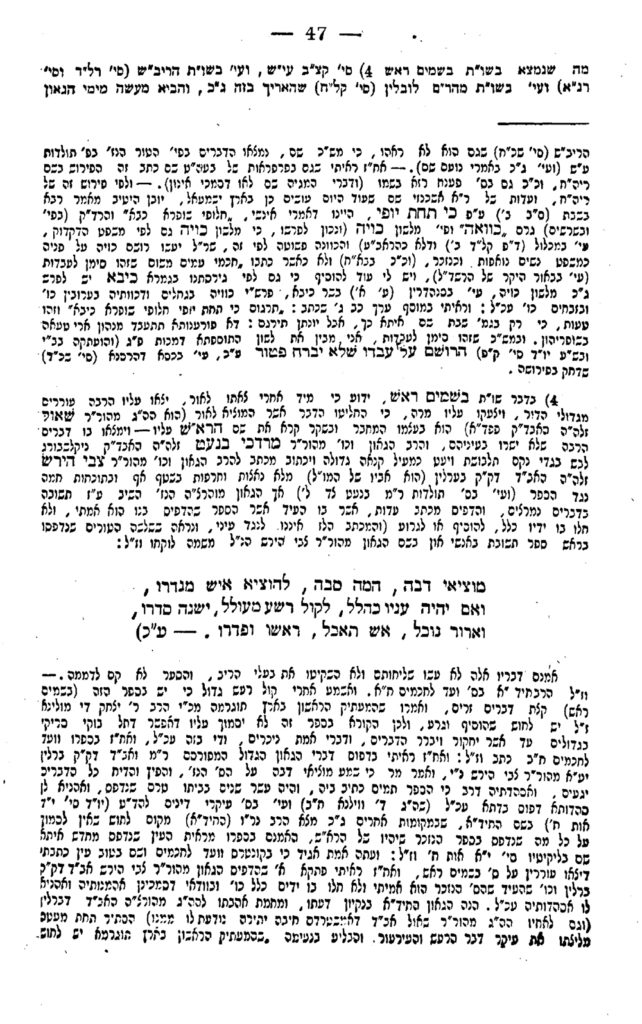
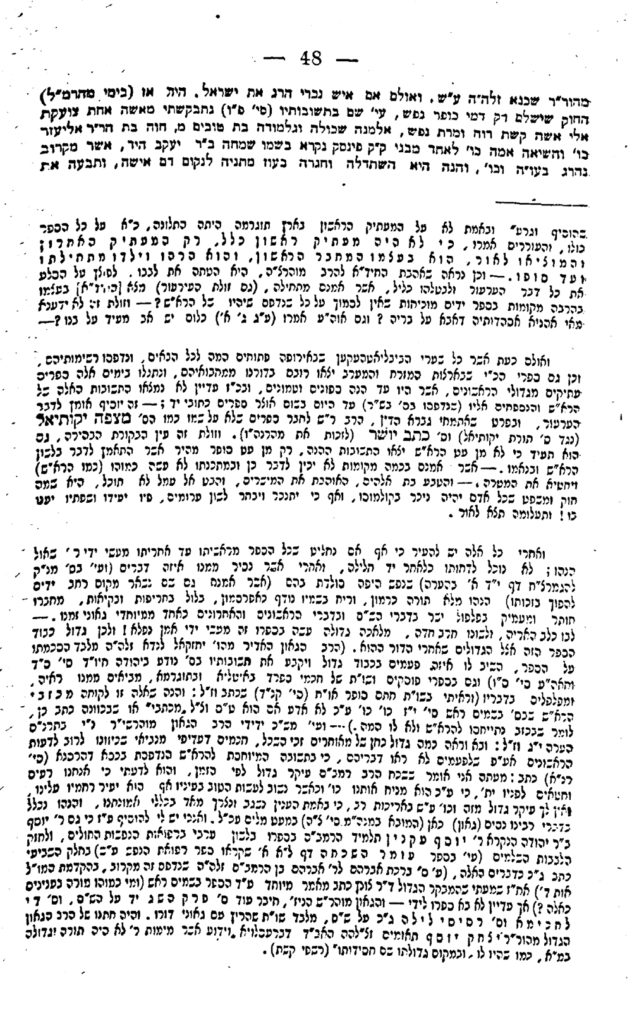
R’ Strashun concludes this lengthy discussion, stating that he heard that: “the great critic Dr. Zunz, wrote a special article on the Besamim Rosh and who is like him in such things, but the work did not reach me yet.” This essay of Zunz was recently translated into Hebrew in Avraham Frankel: Rites of Synagogue Liturgy, Jerusalem 2016, pp.256-258.
In an earlier post we wrote:
In 1984, the BR was reprinted … This edition, edited by R. Reuven Amar and includes an extensive introduction, Kuntres Yafe le-Besamim, about BR. Additionally, commentary on the BR by various rabbis is included. The text of this edition is a photo-mechanical reproduction of the first edition. This edition contains two approbations, one from R. Ovadiah Yosef, who in his responsa accepts that BR is a product of R. Saul Berlin, but R. Yosef holds that doesn’t diminish the BR’s value. The second approbation is from R. Benyamin Silber. But, R. Silber provides notes in the back of this edition and explains that he holds the BR is a forgery and that he remains unconvinced of Amar’s arguments to the contrary.[1]
For many years this 1984 version of the BR has been almost impossible to find. A few weeks ago, a very limited run of the 1984 BR edition was reprinted and is available exclusively via Mizrahi Books.
Mention the Seforim Blog & the price is $22. Postage is $4 for one volume, and just $1 for each additional copy and naturally it can be picked up at the store as well. International postage is available at cost, contact Israel Mizrahi for an exact quote (call 347.492.6508). Payment can be made via paypal, credit card over the phone, check, or money order (if sending money, the address is 3114 Quentin Rd, Brooklyn, NY 11234). Contact info and PayPal is to bluebirds15@yahoo.com. It can also be ordered online here.
[1] To add to Samet’s and Amar’s very comprehensive lists of acharonim who quote the BR, see Eliezer Brodt, Yeshurun 24 (2011), pp. 426-427. See also Eliezer Brodt, Besamim Rosh in Galicia (forthcoming) IYH.
Three New Books
By Eliezer Brodt
In this post I would like to briefly describe three new works, which are hot off the press. For a short time, copies of these three works can be purchased through me for a special price. Part of the proceeds will be going to support the efforts of the Seforim Blog. Contact me at Eliezerbrodt@gmail.com for more information.
The first title is printed by the World Congress of Jewish Studies:
פירוש רש”י לספר משלי, ההדירה והוסיפה מבוא והערות ליסה פרדמן
Lisa Fredman’s, Rashi’s Commentary on the Book of Proverbs is a critical edition of Rashi on Mishlei based on numerous manuscripts. It includes a very extensive introduction and many valuable notes throughout the volume. Critical editions of Rashi are always welcome and very important, sadly not enough of them exist. One section in the introduction which I found interesting relates to Rashi and his responding to Christians and Christianity specifically in his work on Mishlei.
Here is the table of contents for this work:

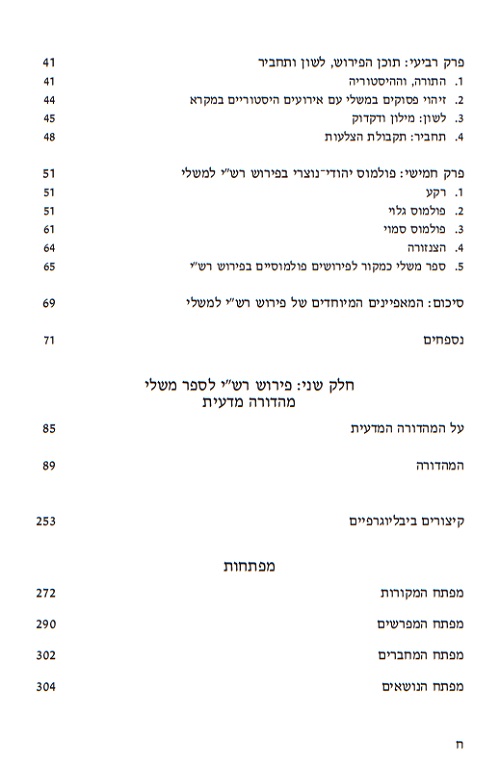
מגנזי אירופה כרך שני ההדיר והוסיף מבואות, שמחה עמנואל, 408 עמודים
The Second volume which I am very happy to announce is the publication of an important work which I have been eagerly waiting for, Professor Simcha Emanuel of the Hebrew University’s Talmud department’s volume of texts from the “European Genizah”, volume two. This volume was just printed by Mekitzei Nirdamim and is being sold by Magnes Press. [Volume one was mentioned earlier on the blog here]. For a sample chapter e mail me at Eliezerbrodt@gmail.com.
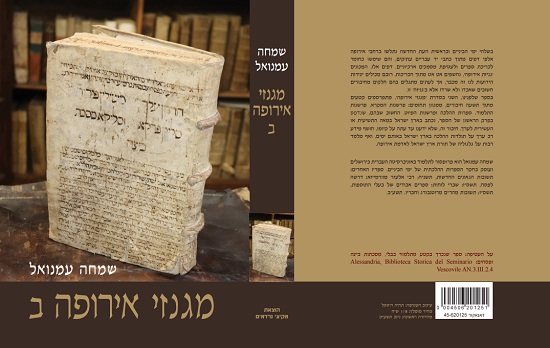
Professor Emanuel is considered one of the today’s greatest experts in Rishonic literature. He has produced numerous special works [such as this recent work, this, this and my favorite] and articles of both texts and material about them for quite some time. [Many of which are available here] All of which are of very high quality, showing an incredible breadth and depth in the material at hand. One area of specialty of his is finding long-lost works; this new volume continues this trend. It includes numerous newly discovered texts of Rishonim, with introductions and background of their importance and proof of identification. Some of the discoveries are simply put remarkable detective work, how he pieces together the various pieces of the puzzle.
The author writes in the abstract of the book as follows:
The purpose of this volume, like its predecessor, is to uncover fragments of important Hebrew works hidden in the “European Genizah”. Thousands of pages of Hebrew manuscripts have been discovered in this “Genizah”, which is scattered in hundreds of libraries and archives throughout Europe and even beyond. In the late medieval and early modern eras, these pages were used to bind books and as folders of archival documents. In the first volume of this series, I published eleven new works from the “European Genizah”, prefacing them with a wide-ranging introduction about the nature of this “Genizah”. Nine additional works are published in the present volume.
The works published herein are from a variety of genres: Biblical exegesis, Talmud commentary, halakhic literature, and liturgical interpretation. They appear in this volume in chronological order, from earliest to latest. The most significant of the works is also the work whose discovery required more effort than all of the others; it appears in the first chapter of the book. This work was written — I wish to argue — in ninth or tenth-century Palestine. It reveals valuable information on the history of halakhah in Palestine of that era, and also teaches a great deal about how Palestinian Traditions made their way to the European continent. This work still requires a great deal of study, and I hope that others come along to add to my words. The fragments published here were identified in the collections of fourteen archives and libraries. These institutions, located throughout Europe, aptly reflect the dispersal of the European Geniza.
Here are the Table of Contents of this special work:

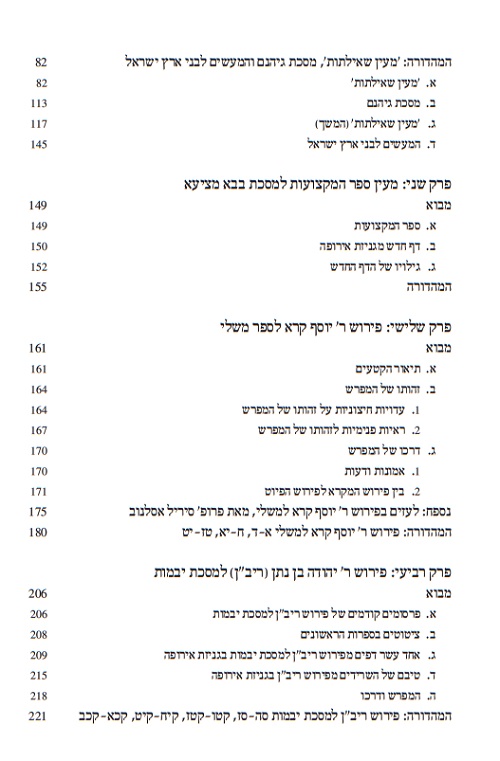
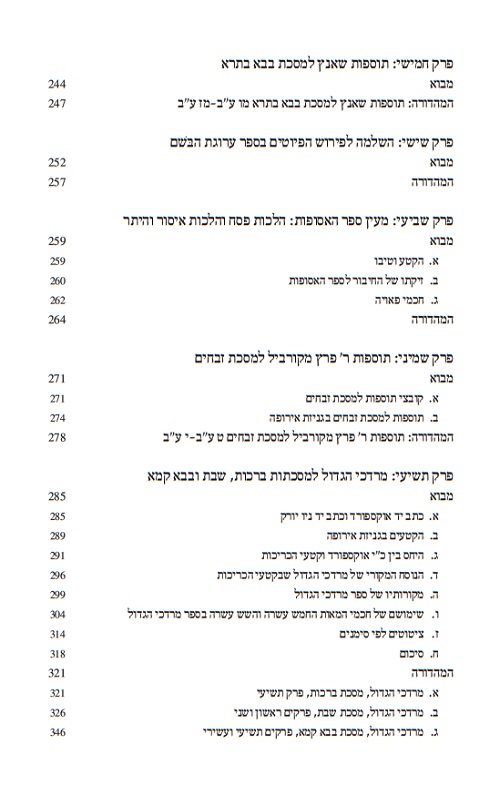
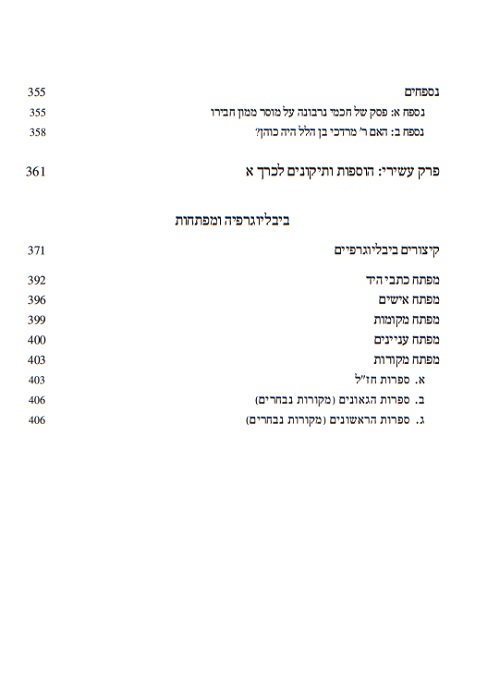
The third work is also printed by the World Congress of Jewish Studies.
שולמית אליצור, סוד משלשי קודש: הקדושתא מראשיתה ועד ימי רבי אלעזר בירבי קליר
This work Sod Meshalleshei Qodesh is written by Professor Shulamit Elizur (see here), one of the worlds leading experts on piyut. Some have claimed this work will change the study of piyut completely. In an interview published in Ami Magazine and reprinted with updates on the Seforim Blog (here) Elizur was asked:
Which sefer do you consider your biggest accomplishment— your magnum opus?”
She replied:
“The one I’m in the middle of writing right now. It’s a sefer on the history of the kedushta, which are the piyutim composed to be recited right before Kedushah. There are many chiddushim in that sefer and also things about Rabbi Elazar Hakalir that I discovered.”
This book is now out and is over one thousand pages!.
The following is the abstract of the book translated into English for the readers of the Seforim Blog by Dr. Gabriel Wasserman (and is not found in the actual book). This will give one a good idea of what the purpose of this work is:
Sod Meshalleshei Qodesh: The Qedushta From its Origins until the Time of Rabbi El‛azar berabbi Qillir
A qedushta is a series of piyyutim for the ‘Amida prayer, which is expanded in honor of the recitation of the Qedusha, and includes many complex components. Its origins are in the Land of Israel, in the fourth or fifth century. We first see it as a constructed composition with set, complex, rules in the work of the poet Yannai, who lived in the mid-sixth century, the teacher of Rabbi El‛azar berabbi Qillir (who is known popularly as “the Qallir”). The qedushta, as it appears in the hundreds of compositions by Yannai and his followers, conceals many secrets: mysterious strings of biblical verses accompany its first components; a fixed biblical verse concludes the third component, followed by the strange words “El Na”; then comes a fourth component, whose structure is free, and always concludes, for some reason, with the word “Qadosh”; the fifth component in Yannai’s compositions is the ‘asiriya, a poem constructed of a truncated alphabetical acrostic from only aleph to yud, followed by a prayer beginning “El Na Le‘olam Tu‘aratz” – and it is unclear why this prayer appears here; then there is a group of poems called rahitim, which are written, for some reason, in unique, stereotypical structures. These are only a fraction of the various strange features of the qedushta’ot of Yannai and the other poets. The discussions in the book are dedicated to suggesting solutions to all these questions, and to others, and involve uncovering fragments of qedushta’ot that preceded Yannai; by examining these texts, they excavate the literary remains to construct a model of the gradual development of the qedushta over time, from its origins until it reached its complex structure in the days of Yannai and Rabbi El‛azar berabbi Qillir.
The first section of the book, which is the largest, is devoted to this development of the qedushta, in all its elements, including those that follow the recitation of Qedusha. Naturally, this section deals with the piyyutim mostly from a structural point of view, for only such an analysis can enable a comprehensive look at the development of the genre. However, as a base for these structural analyses, this section contains the texts of many piyyutim, mostly pre-classical (from the period before Yannai, when the poets did not yet use rhyme). Alongside them are printed classical rhyming piyyutim, too, from the period of Yannai and his colleagues, and, in a few instances, even piyyutim from later periods.
The second section of the book focuses on one single poet: Rabbi El‛azar berabbi Qillir, the most prolific of the classical poets in the Land of Israel, whose poems reached Europe, and some of them are recited in Ashkenazic and Italian synagogues through today. The qedushta’ot of Rabbi El‛azar berabbi Qillir are varied in both their structures and their styles, much more than those of Yannai; this section is devoted to an analysis of these compositions, and an attempt to map out which ones are earlier and which later. On the basis of precise structural analysis, the section builds a higher level of analysis – stylistic; and thus we see the picture of the great poet’s literary journey. It becomes clear that when he was started out, he was heavily influenced by the work of Yannai, and slowly he created new ways for himself: at first he went in the direction of obscurity and difficulty, which he gradually made more and more obscure; but then, in a later, more mature phase, he turned to pure lyrical song, which today’s reader, too, will find sweet.
The third section leaves aside the structural analyses, and suggests directions for further research. This section is short, and contains only first steps towards new directions in piyyut analysis. It focuses primarily on content, and ways that the qedushta’ot are organized, but it moves on to questions of how the qedushta is constructed as a complete composition, and points out various difficulties that the poets needed to overcome, and analyzes at length their literary solutions to these problems. Yannai stands at the center of the discussion in this section, but there are also notes about other poets. Most of the suggested directions for further research are new, and we hope that they will lead to further productive scholarship, and make it possible to study the piyyutim from angles that have hitherto been less examined.
Throughout the book, phenomena are demonstrated by means of the texts of piyyutim. More than 250 piyyutim are printed in the book, of which about 130 are being printed for the first time. Most of these piyyutim are from the earlier periods of piyyut, and their publication in this volume reveals the full contribution of these layers of the genre to our understanding of the history of the qedushta. Even the piyyutim that have already been printed elsewhere often were published in out-of-the-way publications, some of them with no vowels or commentary. It goes without saying that for this volume, these texts were all printed anew straight from the manuscripts. When pieces from Yannai’s work are cited to exemplify some point, an attempt has been made, inasmuch as possible, to use pieces that have not been included in the existing publications of his work, and thus the volume contributes a great amount of new material to the corpus of Yannai’s piyyutim. The volume as a whole is based on examination of hundreds of manuscripts, mostly from the Cairo Geniza, and these provide a wide, firm textual basis to the analysis.
The book is intended first and foremost for scholars, but it will also enable people interested in piyyut and its history from outside the world of academia to gain exposure to a great corpus of early piyyutim, among which are several stunningly beautiful gems, which are being published here for the first time.
For the Hebrew abstract email me at eliezerbrodt@gmail.com
Here is the table of contents:
